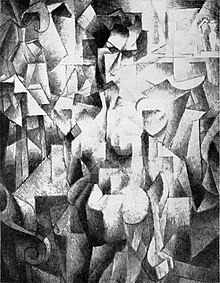
Cubism is an early-20th-century avant-garde art movement begun in Paris that revolutionized painting and the visual arts, and influenced artistic innovations in music, ballet, literature, and architecture. Cubist subjects are analyzed, broken up, and reassembled in an abstract form—instead of depicting objects from a single perspective, the artist depicts the subject from multiple perspectives to represent the subject in a greater context. Cubism has been considered the most influential art movement of the 20th century. The term cubism is broadly associated with a variety of artworks produced in Paris or near Paris (Puteaux) during the 1910s and throughout the 1920s.

Events from the year 1911 in art.
Events from the year 1912 in art.

Jean Dominique Antony Metzinger was a major 20th-century French painter, theorist, writer, critic and poet, who along with Albert Gleizes wrote the first theoretical work on Cubism. His earliest works, from 1900 to 1904, were influenced by the neo-Impressionism of Georges Seurat and Henri-Edmond Cross. Between 1904 and 1907, Metzinger worked in the Divisionist and Fauvist styles with a strong Cézannian component, leading to some of the first proto-Cubist works.
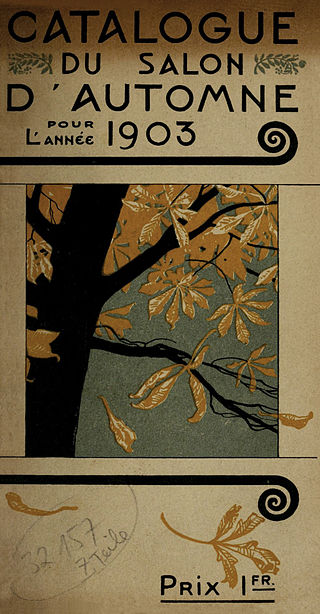
The Salon d'Automne, or Société du Salon d'automne, is an art exhibition held annually in Paris. Since 2011, it is held on the Champs-Élysées, between the Grand Palais and the Petit Palais, in mid-October. The first Salon d'Automne was created in 1903 by Frantz Jourdain, with Hector Guimard, George Desvallières, Eugène Carrière, Félix Vallotton, Édouard Vuillard, Eugène Chigot and Maison Jansen.
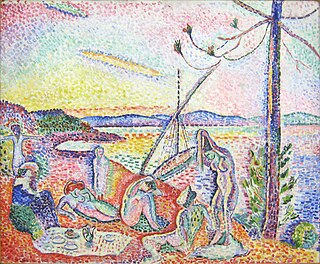
The Société des Artistes Indépendants or Salon des Indépendants was formed in Paris on 29 July 1884. The association began with the organization of massive exhibitions in Paris, choosing the slogan "sans jury ni récompense". Albert Dubois-Pillet, Odilon Redon, Georges Seurat and Paul Signac were among its founders. For the following three decades their annual exhibitions set the trends in art of the early 20th century, along with the Salon d'Automne. This is where artworks were often first displayed and widely discussed. World War I brought a closure to the salon, though the Artistes Indépendants remained active. Since 1920, the headquarters has been located in the vast basements of the Grand Palais.

Henri Victor Gabriel Le Fauconnier was a French Cubist painter born in Hesdin. Le Fauconnier was seen as one of the leading figures among the Montparnasse Cubists. At the 1911 Salon des Indépendants Le Fauconnier and colleagues Jean Metzinger, Albert Gleizes, Fernand Léger and Robert Delaunay caused a scandal with their Cubist paintings. He was in contacts with many European avant-garde artists such as Wassily Kandinsky, writing a theoretical text for the catalogue of the Neue Künstlervereinigung in Munich, of which he became a member. His paintings were exhibited in Moscow reproduced as examples of the latest art in Der Blaue Reiter Almanach.
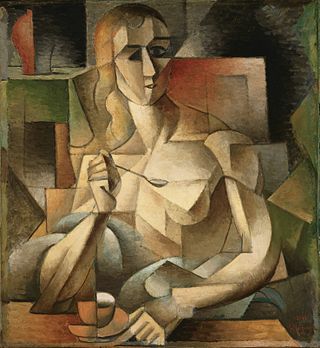
Tea Time is an oil painting created in 1911 by the French artist and theorist Jean Metzinger. It was exhibited in Paris at the Salon d'Automne of 1911, and the Salon de la Section d'Or, 1912.

Proto-Cubism is an intermediary transition phase in the history of art chronologically extending from 1906 to 1910. Evidence suggests that the production of proto-Cubist paintings resulted from a wide-ranging series of experiments, circumstances, influences and conditions, rather than from one isolated static event, trajectory, artist or discourse. With its roots stemming from at least the late 19th century, this period is characterized by a move towards the radical geometrization of form and a reduction or limitation of the color palette. It is essentially the first experimental and exploratory phase of an art movement that would become altogether more extreme, known from the spring of 1911 as Cubism.

La danse is an oil painting created circa 1906 by the French artist and theorist Jean Metzinger (1883–1956). Bacchante is a pre-Cubist or Proto-Cubist work executed in a highly personal Divisionist style during the height of the Fauve period. Bacchante was painted in Paris at a time when Metzinger and Robert Delaunay painted portraits of one another, exhibiting together at the Salon d'Automne and the Berthe Weill gallery. Bacchante was exhibited in Paris during the spring of 1907 at the Salon des Indépendants, along with Coucher de soleil and four other works by Metzinger.

Du "Cubisme", also written Du Cubisme, or Du « Cubisme », is a book written in 1912 by Albert Gleizes and Jean Metzinger. This was the first major text on Cubism, predating Les Peintres Cubistes by Guillaume Apollinaire (1913). The book is illustrated with black and white photographs of works by Paul Cézanne (1), Gleizes (5), Metzinger (5), Fernand Léger (5), Juan Gris (1), Francis Picabia (2), Marcel Duchamp (2), Pablo Picasso (1), Georges Braque (1), André Derain (1), and Marie Laurencin (2).
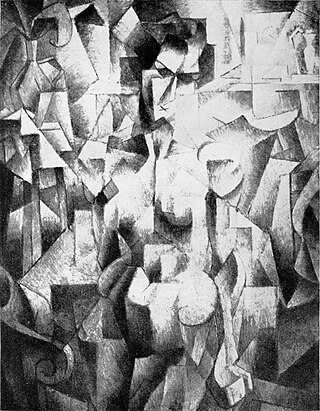
Nu à la cheminée, also referred to as Nu dans un intérieur, Femme nu, and Nu or Nude, is a painting by Jean Metzinger. The work was exhibited in Paris at the Salon d'Automne of 1910, and the Salon de la Section d'Or, Galerie La Boétie in Paris, October 1912. It was published in Du "Cubisme", written by Jean Metzinger and Albert Gleizes in 1912, and subsequently published in The Cubist Painters, Aesthetic Meditations by Guillaume Apollinaire, 1913. By 1912 Nu à la cheminée was in the collection of M.G. Comerre. The work has not been seen in public since, its current location is unknown.

Woman with Phlox is an oil painting created in 1910 by the French artist Albert Gleizes. The painting was exhibited in Room 41 at the Salon des Indépendants in the Spring of 1911 ; the exhibition that introduced Cubism as a group manifestation to the general public for the first time. The complex collection of geometric masses in restrained colors exhibited in Room 41 created a scandal from which Cubism spread throughout Paris, France, Europe and the rest of the world. It was from the preview of the works by Gleizes, Jean Metzinger, Henri Le Fauconnier, Robert Delaunay, and Fernand Léger at the 1911 Indépendants that the term 'Cubism' can be dated. La Femme aux Phlox was again exhibited the following year at the Salon de la Section d'Or, Galerie La Boétie, 1912. La Femme aux Phlox was reproduced in The Cubist Painters, Aesthetic Meditations by Guillaume Apollinaire, published in 1913. The same year, the painting was again revealed to the general public, this time in the United States, at the International Exhibition of Modern Art, New York, Chicago, and Boston. The work is now in the Museum of Fine Arts, Houston, Gift of the Esther Florence Whinery Goodrich Foundation in 1965.

The Harbor, is a painting by the French artist Jean Metzinger. The work was exhibited in the spring of 1912 at the Salon des Indépendants in Paris, and at the Salon de La Section d'Or, Galerie La Boétie, October 1912, Paris,. Le Port was reproduced a few months later in the first major text on Cubism entitled Du "Cubisme", written in 1912 by Jean Metzinger and Albert Gleizes, published by Eugène Figuière Editeurs the same year. The Harbor was subsequently reproduced in The Cubist Painters, Aesthetic Meditations , written by Guillaume Apollinaire, published by Figuière in 1913. At the Salon des Indépendants of 1912, Apollinaire had noticed the classical Ingresque qualities of Metzinger's Le Port, and suggested that it deserved to be hung in the Musée du Luxembourg's modern art collection. The dimensions and current whereabouts of Le Port are unknown.

The Hunt is a painting created in 1911 by the French artist Albert Gleizes. The work was exhibited at the 1911 Salon d'Automne ; Jack of Diamonds, Moscow, 1912; the Salon de la Société Normande de Peinture Moderne, Rouen, summer 1912; the Salon de la Section d'Or, Galerie La Boétie, 1912, Le Cubisme, Musée National d'Art Moderne, Paris, 1953, and several major exhibitions during subsequent years.

Passy, Bridges of Paris, also called Les ponts de Paris (Passy), or Paysage à Passy, is a painting created in 1912 by the French artist, theorist and writer Albert Gleizes. The work was exhibited at the Salon de la Société Normande de Peinture Moderne, Rouen, 1912 (titled Passy); the Salon de la Section d'Or, Galerie La Boétie, Paris, 1912 (titled Passy); Manes Moderni Umeni, Vystava, Prague, 1914 (titled Paysage à Passy); and Galerie Der Sturm, Berlin, July, 1914.

Bathers is a Proto-Cubist painting, now lost or missing, created circa 1908 by the French artist and theorist Jean Metzinger. Possibly exhibited during the spring of 1908 at the Salon des Indépendants. This black-and-white image of Metzinger's painting, the only known photograph of the work, was reproduced in Gelett Burgess, "The Wild Men of Paris", Architectural Record, May 1910. The painting was also reproduced in The New York Times, 8 October 1911, in an article titled "The 'Cubists' Dominate Paris' Fall Salon", and subtitled, "Eccentric School of Painting Increases Its Vogue in the Current Art Exhibition - What Its Followers Attempt to Do".
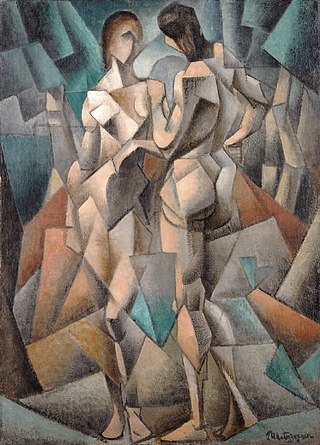
Two Nudes is an early Cubist painting by the French artist and theorist Jean Metzinger. The work was exhibited at the first Cubist manifestation, in Room 41 of the 1911 Salon des Indépendants, Paris. At this exhibition the Cubist movement was effectively launched before the general public by five artists: Metzinger, Gleizes, Le Fauconnier, Delaunay and Léger. This was the first exhibition during which artists, writers, critics and the public at large encountered and spoke about Cubism. The result of the group show is a succès de scandale.

Les Peintres Cubistes, Méditations Esthétiques, is a book written by Guillaume Apollinaire between 1905 and 1912, published in 1913. This was the third major text on Cubism; following Du "Cubisme" by Albert Gleizes and Jean Metzinger (1912); and André Salmon, Histoire anecdotique du cubisme (1912).

The Banks of the Marne is a proto-Cubist oil painting on canvas created in 1909 by the French artist Albert Gleizes. In this work can be seen a departure from the representation of the observable world. The development of Cubist and abstract art in the work of Gleizes was necessarily a transformation from the synthetic preoccupation with his subject matter. The passage of Gleizes' painting from an epic visionary figuration to total abstraction was foreshadowed during his proto-Cubist period. Bords de la Marne measures 54 × 65 cm, and is currently in the permanent collection of the Musée des Beaux-Arts de Lyon.

